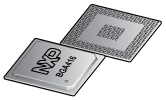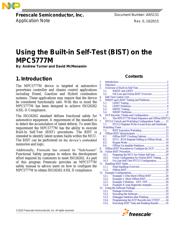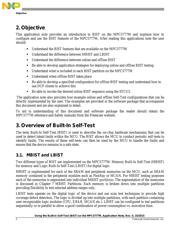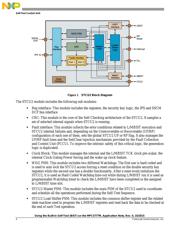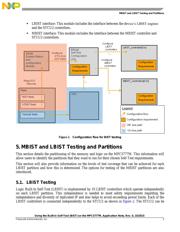
© 2015 Freescale Semiconductor, Inc. All rights reserved.
Using the Built-in Self-Test (BIST) on the
MPC5777M
By: Andrew Turner and David McMenamin
1. Introduction
The MPC5777M device is targeted at automotive
powertrain controller and chassis control applications
including Diesel, Gasoline and Hybrid combustion
systems. These applications may require that the device
be considered functionally safe. With this in mind the
MPC5777M has been designed to achieve ISO26262
ASIL-D Compliance.
The ISO26262 standard defines functional safety for
automotive equipment. A requirement of the standard is
to detect the accumulation of latent defects. To meet this
requirement the MPC5777M has the ability to execute
Built-In Self-Test (BIST) procedures. The BIST is
intended to identify latent system faults within the MCU.
The BIST can be performed on the device’s embedded
memories and logic.
Additionally, Freescale has created its “SafeAssure”
Functional Safety program to reduce the development
effort required by customers to meet ISO26262. As part
of this program Freescale provides an MPC5777M
safety manual to advice users on how to configure the
MPC5777M to obtain ISO26262 ASIL D compliance.
Freescale Semiconductor, Inc.
Document Number: AN5131
Application Note
Rev. 0
,
10/2015
Contents
1. Introduction ........................................................................ 1
2. Objective ............................................................................ 2
3. Overview of Built-In Self-Test ........................................... 2
3.1. MBIST and LBIST .................................................. 2
3.2. Off-Line and Online BIST Overview ...................... 3
4. Self-Test Control Unit ........................................................ 3
5. MBIST and LBIST Testing and Partitions ......................... 5
5.1. LBIST Testing ......................................................... 5
5.2. LBIST Partitions ...................................................... 6
5.3. MBIST Testing ........................................................ 7
5.4. MBIST Partitions .................................................... 8
6. DCF Records, Clients and Configuration ......................... 11
6.1. The MPC5777M Reset Sequence and Offline BIST13
7. STCU2 Unlock and Watchdog Configuration Tasks ........ 15
7.1. STCU2 Register Write Access Keys and Hardware
Watchdog Timer .................................................................. 15
7.2. BIST Execution Watchdog .................................... 15
8. Offline BIST idiosyncrasies ............................................. 15
8.1. Offline BIST Clocking Options ............................. 15
8.2. STCU_RUN Register Setting in Offline Mode ..... 16
8.3. Bypass Mode ......................................................... 16
8.4. Offline Un-testable Partitions ................................ 16
9. Offline BIST Procedure to Configure by DCF ................. 16
10. Online BIST Procedure..................................................... 20
10.1. Preparing the MCU for Online Self-test ................ 20
10.2. Clock Configuration for Online BIST Testing ...... 21
10.3. On-Line Self-Test STCU2 Configuration .............. 21
11. Handling BIST faults ........................................................ 25
11.1. Fault Handling Overview ...................................... 25
11.2. Offline BIST .......................................................... 26
12. Example Configurations ................................................... 27
12.1. Example 1 Ultra Short Offline BIST ..................... 28
12.2. Example 2 Short Offline BIST ............................. 29
12.3. Example 3 Medium – KEY OFF ........................... 30
12.4. Example 4 Long diagnostic example ..................... 31
13. Using the Software Package ............................................. 32
13.1. Package Overview ................................................. 32
13.2. Executing the Software .......................................... 33
13.3. Debugger Interface after Flashing ......................... 34
13.4. Programming the DCF Records into UTEST ........ 34
13.5. Executing BIST Tests and Reading Results .......... 35

